12 Free Online Web Design & Development Classes
Find your perfect college degree
In the middle of today’s do-it-yourself craze, hopeful web designers now find themselves asking if web design and development certificates are worth it.
While everyone must answer this question on their own based on their needs and position, having a certificate in web design gives you a good chance to land an entry-level position in this field.

How can you convince your potential employer that you indeed have the skills and knowledge? A certificate is just that, the proof of your competence.
After earning the necessary certificates, you can proudly advertise and display them to those you wish to work with. This will speak for itself and provide you with the crucial validation and credibility that will help you get your dream job.
But before we dive more into these online college courses for web design and development, let’s first understand the basics.
The Top 12 Free Online College Courses for Web Design and Development
Between hundreds of blogs, dozens of online learning platforms, and YouTube, you can find an endless amount of web design and development courses and learning materials online. However, not all of them have the same quality. If you start with the wrong course, you’ll end up wasting time doing something useless.
So, here are 12 of the best and most up-to-date web design courses to help you kickstart a good career as a web designer and developer.
Introduction to HTML5
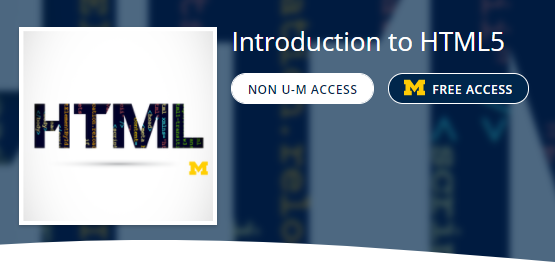
The University of Michigan, via Coursera
This free online course, delivered via Coursera, is designed to help budding web designers and developers who wish to gain better knowledge and confidence in the field.
You will explore the practical (what you need to know to make your web page), the theory (what happens when someone clicks a link on a webpage), and the overlooked (what to do after you complete a web page).
In addition, the introduction to HTML will strongly focus on following the semantic standards to promote better accessibility for users with a disability and adhering to syntactic standards for validation.
The book used in the course is available online: “The Missing Link: An Introduction to Web Development and Programming” by Michael Mendez. While this online course is suitable for many people, this is ideal if you like a step-by-step description of the basics.
No prerequisites are required upon entry, and it’s already assumed that enrollees have no background or experience in programming or IT.
Best Features
- 100% online and free
- Shareable Certificate
- The course takes 13 hours to complete
- Taught by industry experts Charles Russell Severance, a clinical professor, and Colleen van Lent, Ph.D., a lecturer.
HTML, CSS, and JavaScript for Web Developers
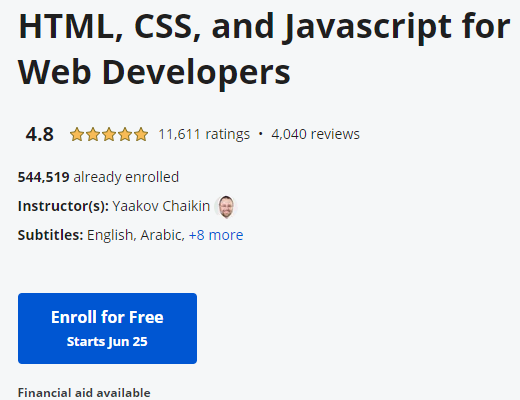
Johns Hopkins University, via Coursera
Have you noticed that the only function of a web application that the user interacts directly with is via the web page? Implement the page poorly, and in just a few seconds, expect your users to leave.
Today’s web users expect so much out of a website. The page must load fast, give them the relevant service, and be user-friendly on all devices: mobile phones, tablets, desktop computers.
This free course will teach you the basic tools that a webpage coder has to know. First, learn from the ground up how you can implement modern web pages with CSS and HTML. From there, you will learn how to code pages and understand their components.
Next, you can code up a page that will be useful on a desktop computer as on a mobile phone. Finally, a thorough introduction to JavaScript is the final stretch of the course.
This coding language is the most popular, ubiquitous, and very powerful. Using JavaScript, you can build a fully functional and running web application that uses Ajax to expose server-side data and functionality to the end user.
Best Features:
- 100% online and free
- Paid Certificate available
- Five weeks long, 40 hours worth of material
- Flexible Schedules
- Taught by Yaakov Chaikin, Adjust Professor, Graduate Computer Science, Whiting School of Engineering
CS50’s Web Programming with Python and JavaScript
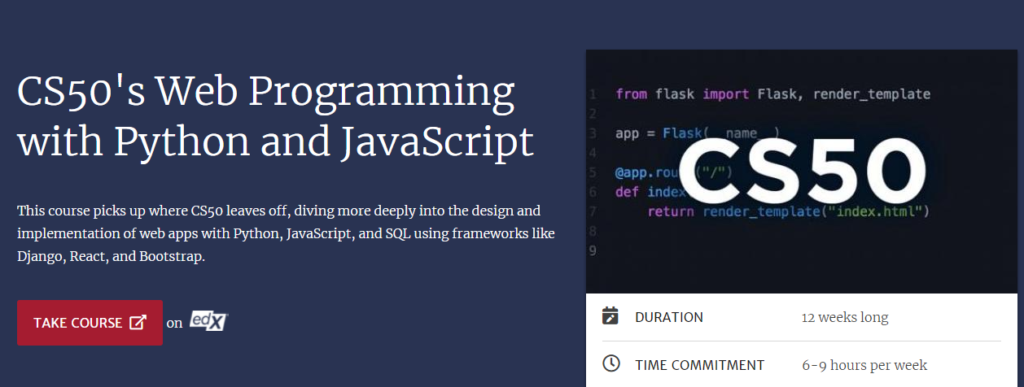
Harvard University, via edX
This is a free, 12-week-long web development course designed for intermediate programmers. CS50’s Web Programming with Python and JavaScript dives further into the implementation and design of web applications with JavaScript, Python, and SQL and uses Bootstrap, React, and Django frameworks.
Some of the topics included in the course are scalability, database design, security, and user experience. Through the course’s hands-on projects, you will also learn how to write and use APIs, leverage cloud services like Heroku and Github, and create interactive UIs.
After completing the course, you emerge more knowledgeable and experienced in languages, principles, and tools that encourage you to create and deploy applications on the Internet. The course is part of Harvard University’s Computer Science for Web Programming.
Best Features:
- 100% online and free
- Self-paced
- Verified Certificate available for $199
- Taught by industry experts David J. Malan, Gordon McKay Professor of Computer Science, Harvard John A. Paulson School of Engineering and Applied Sciences, and Colton Ogden, Technologist from Harvard University.
Building Web Applications in PHP
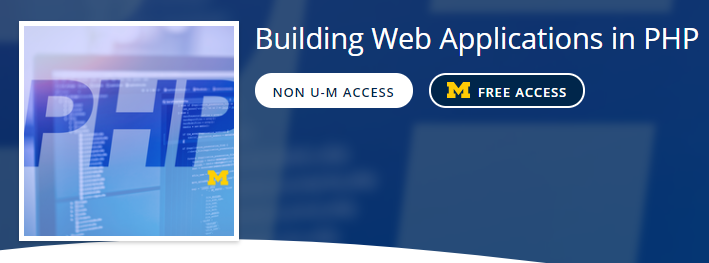
The University of Michigan, via Coursera
This course lets you explore a web application’s basic structure and teaches you how a browser interacts with the web server. Offered by The University of Michigan (through Coursera), you are introduced to the response/request cycle like Redirect/GET/POST, plus you also gain an understanding of HTML (Hypertext Markup Language).
Data structures of the PHP language, logic, variables, arrays, iteration, superglobal variables, error handling, and basic syntax are also part of the course.
As a budding web developer, you are responsible for styling your web pages, and the CSS (Cascading Style Sheets) class will help you achieve just that. Finally, after the course, you will learn valuable knowledge and skills about installing and using an integrated MySQL/PHP environment like MAMP or XAMPP.
To sum it all up, the syllabus of this course include:
- Introduction to Dynamic Web Content
- HyperText Markup Language (HTML)
- Cascading Style Sheets (CSS)
- Installing PHP and SQL
- Introduction to PHP
- PHP Arrays
- PHP Functions
- PHP and HTML Forms
Best Features:
- 100% online and free
- Paid Certificate available
- Eight weeks long, 30 hours worth of material
- Part of the Web Applications for Everybody program
- Taught by Charles Russell Severance, Clinical Professor, School of Information, University of Michigan.
Web Development and Design Using WordPress
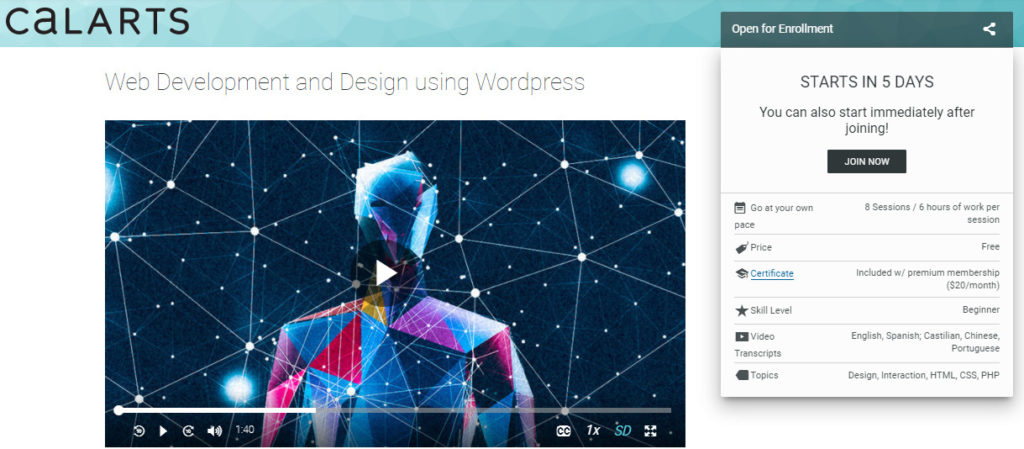
California Institute of the Arts, via Kadenze
Today’s world is digitally connected; thus, the need for an engaging and distinctive website is necessary for creators, designers, artists, and musicians. Through this free online course, you are provided with a basic introduction to web design and development for the artist, giving you the right tools to make and maintain a unique identity online.
In addition, this self-paced course offered by the California Institute of the Arts and delivered via Kadenze teaches you how to create a custom website to have an online artistic portfolio and presence, and you will understand how to step up your content management system.
The course is also perfect for learning HTML, PHP, and CSS, the three major building blocks of today’s modern Web. In addition, you are taught the important skills for the organization and design of your website so that you can make a site that is both engaging and visually distinctive.
Part of the program is weekly assignments designed to develop your actual, live site from basic HTML to a more full-featured site with analytics, galleries, social media integration, and other advanced features.
Best Features:
- 100% online and free
- Paid Certificate available
- Self-paced
- Handled by Spencer Salazar, a computer musician, and researcher presently serving as Special Faculty at California Institute of the Arts and Music.
How to Create a Website in a Weekend – Project-Centered Course
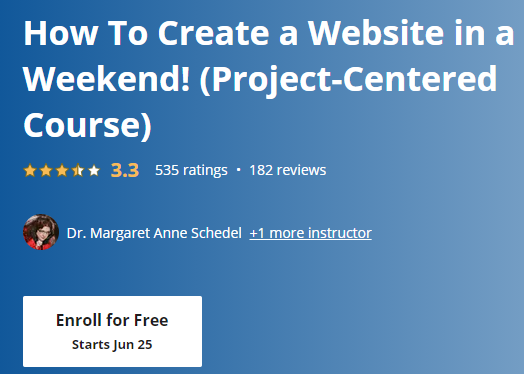
The State University of New York, via Coursera
This project-centered course teaches you how to design, build, and the public a basic website that integrates sound, texts, hyperlinks, images, social media interactivity, and plug-ins.
Step-by-step instructions are provided, along with tips, exercises, and the right tools that enable you to make a domain name, design an attractive layout for your web pages, and categorize your content properly.
From the course, you will also learn how to ensure that your website functions properly across various operating systems and on mobile devices, how to keep your site safe, and of course, how to reach out to people so they will know that your site exists.
You also learn how to track your visitors, and you get to engage in discussion and collaboration with your fellow learners via the program’s forums and peer reviews.
After completing your first website using WordPress, you have the choice to extend your module. This time, it will cover more advanced techniques like coding in HTML, JavaScript, CSS, or simply using a simple text editor.
Best Features:
- 100% online and free
- Paid Certificate Available
- Shareable Certificate
- Takes about 14 hours to complete
- Taught by Dr. Margaret Anne Schedel, and Melissa Clarke
Introduction to CSS3
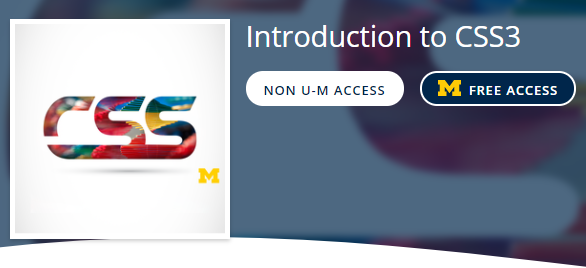
The University of Michigan, via Coursera
This is a free, four-week online course that teaches you the basics of Cascading Style Sheets (CSS3). It heavily focuses on creating CSS rules, testing code, and establishing good and solid programming habits. When you do it correctly, the layout and style of your webpage can significantly improve your site.
To guarantee that the sites will not create barriers for people with physical or cognitive disabilities, you will learn to check pages using standardized POUR accessibility guidelines.
By completing the course, you will be adept at sketching a design for a given HTML page. Using this design, you will utilize CSS in implementing these designs by adding colors, layouts, and fonts.
Best Features:
- 100% online and free
- Paid Certificate available
- Four weeks long, 11 hours worth of material
- Colleen Van Lent, Lecturer, and Charles Severance, Clinical Professor, School of Information, University of Michigan
Web Design: Strategy and Information Architecture
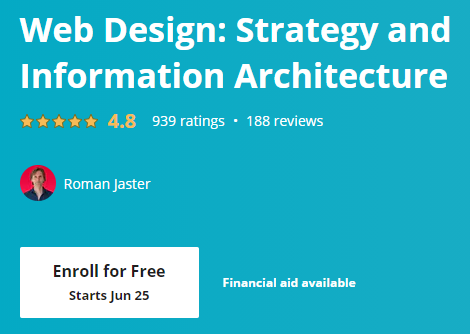
California Institute of the Arts, via Coursera
This is an intermediate-level free online course offered by the California Institute of the Arts, delivered through Coursera.
The course is focused on the early UX (user experience) challenges of planning, research, setting goals, developing interactive sequences, structuring content, and understanding the user.
Although the theories covered in this course translate to different types of interactive media (games, digital kiosks, apps), the program focuses on creating responsive and contemporary websites.
You will complete a large-scale project during the first half of this four-week course to develop an extensive plan for a complex website. You define the strategy and the scope of the site and at the same time, develop the site’s information structure and overall structure.
Best Features:
- 100% online and free
- Paid Certificate available
- Flexible Deadlines
- Shareable Certificate
- Four weeks long, 11 hours worth of material
- Suitable for intermediate-level students
- Taught by Roman Jaster, Visiting Faculty, Program in Graphic Design, California Institute of the Arts
Interactivity with JavaScript
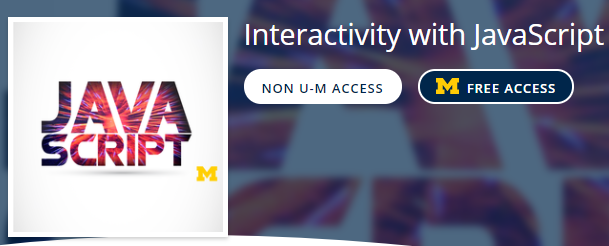
The University of Michigan, via Coursera
Do you wish to take your website to a whole new level? If so, it’s a must to incorporate interactivity into your website. However, adding these advanced capabilities will need a more solid programming language than CSS3 or HTML. Enter JavaScript, the very program that can give you just what you need.
It helps to understand this web development language to make a page that will reach even the most common events like mouse clicks, page load, movements, and even keyboard inputs.
In this course, you will learn the basics of the JavaScript language. In addition, this four-week-long free online course will cover several concepts like looping, variables, functions, and a bit about debugging tools.
You will also understand how JavaScript uses the Document Object Model (DOM) in identifying and modifying specific parts of your webpage. Once you complete the course, you can react to DOM Events easily.
As a result, altering your content and styling your page now becomes more dynamic. The class finishes with a final project—creating an interactive HTML5 form that can accept and verify the input.
Before enrolling in the class, you must have basic knowledge of CSS and HTML.
Best Features:
- 100% online and free
- Paid Certificate available
- Flexible deadlines
- Shareable Certificate
- Takes about 9 hours to complete
- Taught by Colleen van Lent, Ph.D., and Charles Russell Severance
Java Programming: Solving Problems with Software
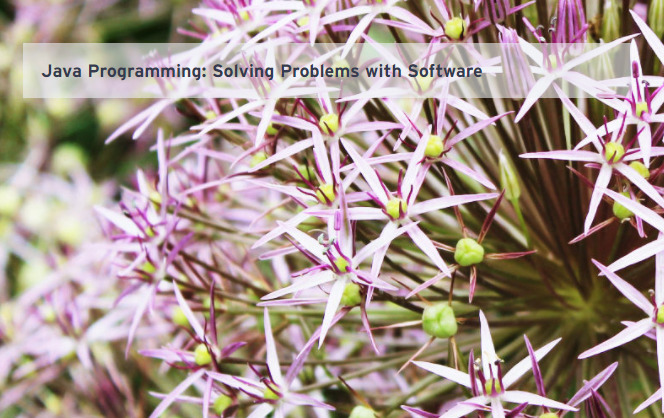
Duke University, via Coursera
This course is perfect for novice web developers. You will learn Java coding and considerably improve your programming and problem-solving skills.
From designing algorithms to developing and debugging programs, this basic course uses custom open-source classes. You will create programs that can access and transform websites, images, and other types of data.
Upon completing this free program, you can make full and running programs that, among others, determine the popularity of baby names in the US just by analyzing CSV (comma-separated value) files.
Best Features:
- 100% online and free
- Flexible schedules
- Shareable Certificate
- Takes 17 hours to complete
- Taught by Owen Astrachan, Robert Duvall, Andrew D. Hilton, and Susan H. Rodger, all industry experts and professors from Duke University.
Java Programming: Arrays, Lists, and Structured Data
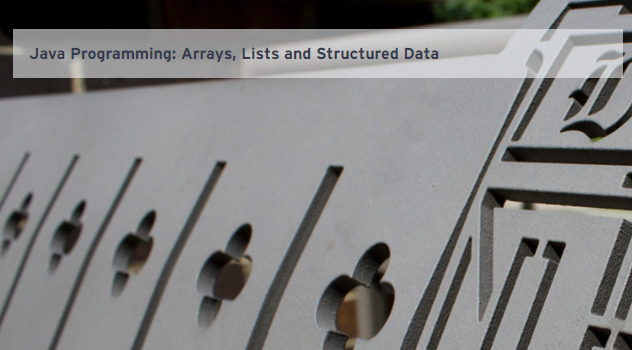
Duke University, via Coursera
Boost your software engineering skills from the previous course, “Java Programming: Solving Problems with Software,” by learning new data structures. You can use these structures in creating more complex programs that use object-oriented features from Java.
For example, by completing this course, you will create an encryption program and a program to break your encryption algorithm.
After you finish the program, you should be able to:
- Solve problems that involve data files
- Read and write data to or from files
- Create quantitative analyses of data
- Store and manipulate data from an ArrayList
- Combine different classes to solve bigger problems
- Use collections and iterables in Java
Best Features:
- 100% online and free
- Paid Certificate available
- Suitable for beginners
- Four weeks long, 14 hours worth of material
- Taught by Andrew D. Hilton, Robert Duvall, Owen Astrachan, and Susan H. Rodger
Single Page Web Application with AngularJS
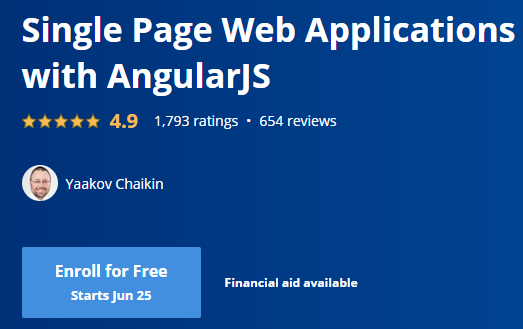
Johns Hopkins University, via Coursera
This is an intermediate-level, free online course that teaches you how to create powerful, testable, and maintainable front-end applications faster, sans the many confusing codes. Developed and backed by Google, AngularJS is one of the more marketable skills you need to acquire.
In this almost 47-hour program, you will explore and study the core design of AngularJS 1.x, its code organization techniques, and its components.
You get to create reusable components of HTML that take advantage of AngularJS data binding features and extend HTML syntax using AngularJS’ one of the most powerful features—directives. You can then improve the functionality of your app by using dependency injection to reuse the current services and create your own.
At the end of this free online course, you can now create a well-organized and fully functional application using AngularJS.
Best Features:
- 100% online and free
- Flexible Deadlines
- 47 hours to complete
- Shareable Certificate
- Suitable for Intermediate Level web developers
- Taught by Yaakov Chaikin, Adjunct Professor, Graduate Computer Science, John Hopkins University
Enroll in web design and development courses online to boost your design and programming skills and further advance your career.
Today, many free online classes will help you understand the platforms and technologies used to access web content. Take advantage of these courses to develop your professional web designing abilities.
Frequently Asked Questions
What is Web Design and Development?
As its name implies, web development means developing a website for Internet use. There are several processes involved when talking about building a design and getting the site up and running.
It involves designing, programming, coding, and so much more. Web development specifically deals with the programming side of the development that allows the website to function properly and run smoothly. Web design and development is primarily the non-design aspect of making a website.
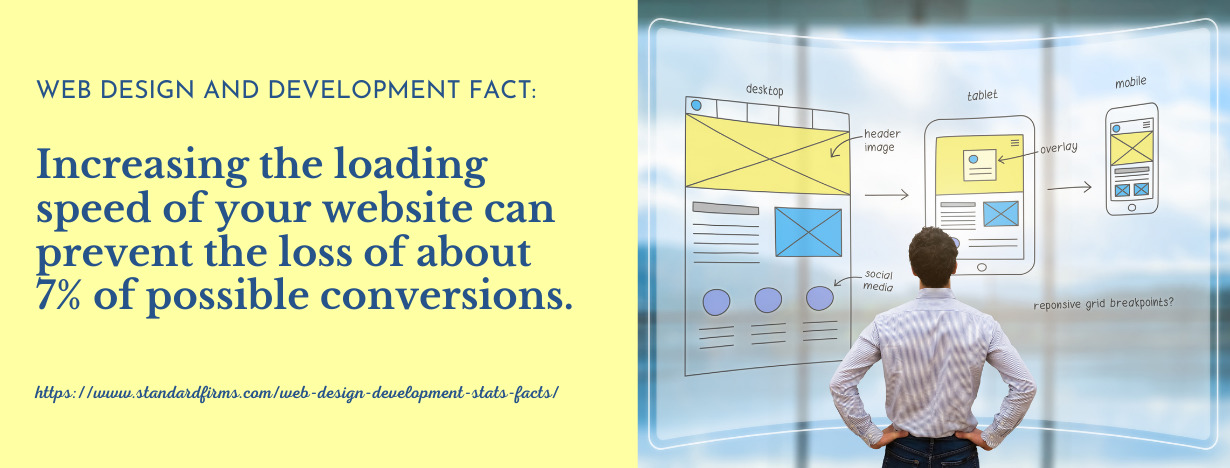
What Skills Do You Need to Become a Successful Web Designer?
If you are still a beginner in technology, it’s challenging to figure out just where and how you can start. This is where web design comes into the picture.
You can choose so many paths—from design and development to digital marketing and every possible field of specialization you can even think of. This field is usually the best place to try, especially if you’re still a newbie to the scene.
Like any tech world role, becoming a web designer will require your analytical and creative sides. So, what are the tech and soft skills required to ace your career in web design?
While web designing offers you versatile careers with amazing opportunities in the future, it’s best to find out what you need to be successful in this field.
Tech Skills. First, you need to go over the technical aspects of becoming a successful web designer. All those strange terms and acronyms sound very intimidating, but they are relatively easy once you’re familiar with them.
- Visual Design. You need ample design knowledge to become a web designer. But do you know what exactly this means? Web designing is a subset of the much bigger field of visual design. Thus, it just makes sense to start from there. Design principles determine the feel and look of a website. The designs can range from typography to proportions to color theory or grid systems.
- UX. An acronym for “user experience” meant to relay how the consumer is feeling (happy, frustrated, calm, etc.) when using a website. UX is all about approaching your web designs from the perspective of the user. You think about how you can design your website that will help your viewers get exactly what they need. To do this, you need to research your potential users and make imaginary “personas” thoroughly. Lay the contents and pages out with a sitemap. By looking at the user flow, you can easily figure out the path users are expected to tread.
- Design Software. Like any ordinary craftsman, you need the necessary tools to get the job done. It’s helpful that you know your way around the standards of the industry. Although you can do a simple web design via a web browser, tools like Adobe Illustrator, Photoshop, and Sketch are usually used by most designers. These tools play critical parts in the job because they can help you create mockups, design assets like images or logos, and enhance or modify photos.
- HTML. Most designers initially thought that learning how to code was not essential for designing. However, most design jobs today expect you to be knowledgeable with HTML (HyperText Markup Language). This is the coding language used to secure content on a website and give it structure. HTML is when you turn simple words into catchy paragraphs, footers, and headlines. This will also help you achieve that “cool” content like graphics, videos, or photos on the website.
- CSS. Cascading Style Sheets (CSS) go hand in hand with HTML. This is the code that instructs the browsers how to style and format HTML for a web page. This means CSS makes all the texts and other content look good. You can change fonts, adjust the colors, add backgrounds, and so much more with CSS. This is exactly where your eye for design will shine and how you can mark your creative stamp on every site you make.

Soft Skills. Now that the tech and design parts are down, you just need to have some soft skills to be more effective and organized in your web design project. These are the common skills many web designers swear by; thus, it’s best to start learning them now.
- Time Management. Whether you’re learning web design to work for a large tech company or just going freelance, you should always be on top of your schedule. As a web designer, your goal is to stand out in your field whenever you can. Therefore, it helps get productivity apps like calendars or task lists, especially if you are working for a large organization. You need to learn project tracking tools as well, such as JIRA or Trello. Regardless of the tools you use, it helps to master the art of tracking and prioritizing your work, especially in the busy world of web design and development.
- Communication. Proper communication skills are also essential for any designer. Without it, don’t expect to make a living from creating websites. After all, your clients should always be updated on the projects you are making for them so that, if needed, they can also pitch in their ideas and suggestions.
- Digital Marketing/SEO/Social Media. The skillset of digital marketing, SEO (search engine optimization, and social media might sound like they are tasks meant for salespersons and marketers and not for web designers. But because the Internet today is the most productive way for many companies to sell their products, it helps that you equip these marketing skills.
- Business or Client Management. As a freelancer or an employee, understanding the bottom line helps you ensure that you or your company is sustainable and profitable. This doesn’t mean you should go back for an MBA. Rather, have the proper idea about the finances and goals of your business or your employer so you can use them in guiding your work. Also, if you’re directly working for clients, make sure you have a plan for making sure that your project backlog and cash flow are both doable and healthy in the long and short term.
How Can You Learn Web Design and Development Online?
There is nothing mind-blowing and mysterious about the skills needed to become a web designer and developer. The question now is how and where you can learn them.
Having a good foundation on the tech side, plus a good handle on the critical organizational parts, will help you get to where you want to be as you build your career and knowledge in web design.
Today, many online classes (both paid and free) cover all the necessary skills needed to become a web designer or developer. These classes often have fast tracks to help you quickly get to your dream career. There are dozens of courses, plus optional course add-ons to help you secure a path in tech.
24/7 access materials are also available, along with an online community of friendly instructors and fellow budding web designers. In just a few weeks, you can find, land, and complete your first-ever paying web design easily.
Are Free Online Web Design & Development Classes Credible?
Yes, free online web design and development classes can be credible, depending on the source, of course. Look for classes created and/or taught by experienced professionals in the web design and development field who have a proven track record of success. Additionally, research the course reviews and ratings to ensure the class is reputable.




